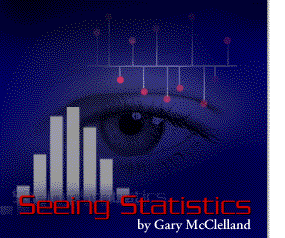
Seeing Statistics is a new approach to teaching statistics using the World Wide Web. This electronic book is based on three premises:
- The important principles of statistics, even the most
difficult ones, are remarkably easy if they can be seen.
- Learning is facilitiated by the active participation of the
student.
- Statistics can be fun!
Seeing Statistics is published by Duxbury Press
and is available at
www.seeingstatistics.com. A free tour of several chapters is
available there.
You may also learn more about Seeing
Statistics by visiting
www.TellDuxbury.com
At that site you will find more examples from Seeing Statistics and additional information.
Normal Probability Calculation Demonstrations
from Seeing Statistics
by
Gary H. McClelland
University of Colorado, Boulder
Seeing Statistics uses over 100 Java applets to make statistics visual. Below are links to demonstration applets useful for finding probabilities related to normal distributions.
- Normal Probabilities. Use this applet to answer all questions
which specify a range of raw or z-scores and ask for the probability.
- Normal Probabilities. This is a more interactive applet than
the previous one; it
allows the use to drag the ends of the included region with the mouse. This
applet is more fun but its accuracy is limited by the resolution of the screen. However, it
may be more educational because the user directly experiences the connection between
the shaded area under the normal distribution and the probability.
- z-scores. Use to answer all questions which specify
a probability and ask for the relevant range of raw or z-scores. Also does
transformations between raw scores and z-scores in either direction. [Note: this is the applet
that was formally found at this link.]
- Normal Tables. This applet illustrates how to use "old-fashioned" tables of normal probabilities. This applet is sometimes tempermental and requires a tall browser window.
The above applets are from Section 7.3, "Working with the Normal Distribution" in Seeing Statistics by Gary McClelland. All rights reserved.